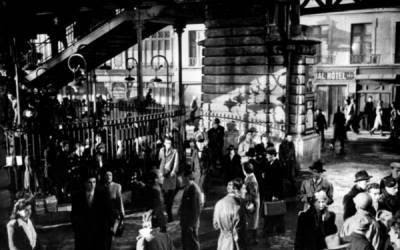I’ve always been interested in the idea of liminal spaces, that strange place which exists, or non-exists, between other things. It’s a concept I explore a great deal in my poetry. It could be the moment between sleeping and waking. It could be a whole film. Brief Encounter appears to be mostly set in a liminal space. Laura (Celia Johnson) and Alec (Trevor Howard) meet on a train station and much of the action takes place here, particularly in the waiting room – a classic liminal space. Their love-affair is doomed from the start – a brief passionate interlude, unrealised and unconsummated as both protagonists are drawn back to their sober, dutiful lives. There are angsty, canted angles when Laura is in danger of going too far (there’s a very film noir kiss in an underpass, shadowy and sinister) or when her state of mind is unbalanced almost to the point of suicide. The film has been called the “Anna Karenina of the home counties” with one critic scathingly saying “make tea, not love”. Audiences at the time were famously irritated with Alec and Laura’s inability to “get a room”! If you ever get the chance to visit the Carnforth Station in Lancashire, where the film was shot, you are in for a treat. It houses an excellent heritage centre with, at its heart, a celebration of David Lean’s 1945 classic. You can even have tea in the faithfully restored Refreshment Room which sports huge, rather intimidating tea urns.

My favourite liminal space, however, is the pier. It’s not sea, it’s not land. As soon as you step onto a pier life feels full of possibilities and difference. Southwold Pier is surely the most unusual you’ll ever encounter.

I last visited in December when Southwold beach was shrouded for hours in a thick sea fret and the pier only came into view as we were almost at the steps. As well as great shops and cafes, the pier is home to Tim Hunkin’s “Under the Pier Show”, a superb collection of unique, hand-built, wacky machines (there’s also an amazing clock halfway down the pier which comes to life on the hour). In the “Mobility Masterclass” you have to get gran across a busy road with her zimmer frame. There’s also the deeply satisfying “Whack the Banker”. The most recent addition is “airbednbug” where a few coins activate a sort of live storyboard about persecuted bedbugs – it’s charming – a comic strip come to life. My favourite moment is when the bedbugs realise they have to move and are leafing through brochures to choose their next hotel to infest – genius!
Is a pier a truly liminal space? A liminal space is one of transition and you could say that piers are really ends in themselves although in the past they probably fulfilled a clearer liminal role as some the first pleasure piers were where you would while away your time as you waited for a steamboat or ferry. One of the earliest pleasure piers was Ryde Pier, built in 1813. There were working piers too, of course, (and still are today), like Wigan, where passengers and cargo were loaded and unloaded.
If you’re a film buff like me then probably your first thought at the mention of piers was Brighton Rock. There’s a great article at the link below
about a Brighton Rock walk given by Julian Clapp. The 1948 version of Graham Greene’s book stars Richard Attenborough as baby-faced evil personified, giving a stunning performance as Pinkie. The film was an immediate sensation and also deeply disturbing for an audience reeling from the horrors of the Second World War, with some critics believing the film shouldn’t be shown. Violence in films was always a concern, with those in control believing that it could have an adverse effect on the suggestible, mostly working class, cinema audiences. Brighton Pier, of course, takes centre stage, with its ghost train, fortune tellers and the “make a record of your voice” booth, used to such great and poignant effect at the end of the film. You can watch the clip below:
Many people who feel the 1948 version is the definitive one were not too keen on the 2010 remake with Sam Riley as the psychopathic Pinkie, and the reliably superb Andrea Riseborough as Rose, but I quite like remakes. It’s always interesting to see how a new version of a classic addresses its audience.

Richard Attenborough renewed his connection with piers by directing the iconic anti-war film Oh What A Lovely War! in 1966. The archetypal Smith family’s experience of the First World War is played out through a series of elaborate tableaux staged mostly on Brighton’s West Pier. It begins with General Haig selling the family entrance tickets to the “show”. At one point, officers zoom down a helter skelter, the perfect metaphor for their heedless and naive decisions.

Hunstanton Pier, or the lack of it, has been a bone of contention in this West Norfolk town for some time. The pier was destroyed by storms in 1978 and the little which remained was more or less destroyed by fire in 2002 and subsequently removed. Before its sad demise, the pier was immortalised in an Ealing comedy from 1956 Barnacle Bill, starring Alec Guinness. Guinness plays a sea captain with seasickness who buys up the old pier and turns it into a non-moving cruise ship, a shipshape vessel which will never go to sea – so we are very much back to the strangeness of liminal spaces. The success of the pier and its new role is very much to the chagrin of the local council who want to demolish it and modernise the promenade (plus ça change…)

As a child, I had an aunt who lived in Hastings whom I used to visit so I have vague memories of the old pier which was destroyed by a fire in 2010. It has just been rebuilt and looks stunning, I can’t wait to visit this stunningly modern new space which was named the UK’s best new building last year.
 Now I’m resident in East Runton and just down the road from Cromer, this, of course, is my new favourite pier. It’s one of only five UK piers with a working theatre and I’m very much looking forward to booking my ticket for the End of the Pier show! The pier itself has had a long and rich history with records of a structure going back as far as the fourteenth century. At night it’s lit up in a magical way and acts as my beacon when I walk along the beach to Cromer on dark evenings.
Now I’m resident in East Runton and just down the road from Cromer, this, of course, is my new favourite pier. It’s one of only five UK piers with a working theatre and I’m very much looking forward to booking my ticket for the End of the Pier show! The pier itself has had a long and rich history with records of a structure going back as far as the fourteenth century. At night it’s lit up in a magical way and acts as my beacon when I walk along the beach to Cromer on dark evenings.
 The pier was the location for “In love with Alma Cogan” directed by Tony Britten. Much of the action took place in the Pavilion Theatre and the plot revolved round Theatre Manager Norman’s resistance to a more commercial show. Norman was played by Roger Lloyd Pack and the film was one of his last appearances on screen. Lloyd Pack was well loved locally, he’d fallen in love with the area in the 1970s after acting in Joseph Losey’s The Go Between alongside Alan Bates and Julie Christie and, as a result, owned a house locally.
The pier was the location for “In love with Alma Cogan” directed by Tony Britten. Much of the action took place in the Pavilion Theatre and the plot revolved round Theatre Manager Norman’s resistance to a more commercial show. Norman was played by Roger Lloyd Pack and the film was one of his last appearances on screen. Lloyd Pack was well loved locally, he’d fallen in love with the area in the 1970s after acting in Joseph Losey’s The Go Between alongside Alan Bates and Julie Christie and, as a result, owned a house locally.
So, my advice to you all is to have a liminal moment. Stand and contemplate life in one of the places in-between – a stairwell, a waiting room, an airport – these are places where reality feels somewhat altered, places which only exist as a means of getting somewhere else or as a resting place. Best of all, go and stand on a pier and enjoy not having to find your sealegs, experience the feeling of walking on water. Buy chips, have a cup of tea, get your fortune told, admire amazing starling murmurations from Brighton’s ruined West Pier or at Aberystwyth. A place of creative pause and contemplation.

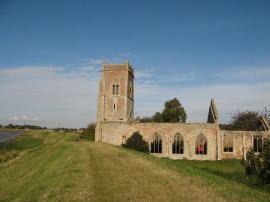
 I’ve just finished The River by Olivia Laing which follows the course of another Ouse, the one in Sussex in which Virginia Woolf took her life in 1941 wearing her heaviest coat, pockets full of stone. It’s a depressing but fascinating book, Laing had just split up with her partner and her sense of anxiety and unease permeates every step as she walks alone in deep contemplation. Occasionally Laing launches herself into the water to cool down and revitalise, these are disturbing moments during which she seems to have little regard for her safety and I held my breath until the next page, willing her to survive. I’ve just reviewed Elizabeth Jane Burnett’s Swims (Penned in the Margins). This powerful collection is a long poem documenting twelve wild swims across the UK’s rivers, lakes and seas. Each poem is an experiment, pushing at the page, seeking freedom from its confines and I thoroughly enjoyed the inventiveness of it. The thought of wild swimming entrances me and I’m even thinking of investing in a wetsuit for all year round sea swimming. Swimming is where I plan my writing workshops and solve poetic problems – that tricky last line, what to leave out, the perfect twist for a line, the revelation of the ideal form to fit the content of the poem – it’s as if the beat of my arms and legs sets up a problem-solving rhythm.
I’ve just finished The River by Olivia Laing which follows the course of another Ouse, the one in Sussex in which Virginia Woolf took her life in 1941 wearing her heaviest coat, pockets full of stone. It’s a depressing but fascinating book, Laing had just split up with her partner and her sense of anxiety and unease permeates every step as she walks alone in deep contemplation. Occasionally Laing launches herself into the water to cool down and revitalise, these are disturbing moments during which she seems to have little regard for her safety and I held my breath until the next page, willing her to survive. I’ve just reviewed Elizabeth Jane Burnett’s Swims (Penned in the Margins). This powerful collection is a long poem documenting twelve wild swims across the UK’s rivers, lakes and seas. Each poem is an experiment, pushing at the page, seeking freedom from its confines and I thoroughly enjoyed the inventiveness of it. The thought of wild swimming entrances me and I’m even thinking of investing in a wetsuit for all year round sea swimming. Swimming is where I plan my writing workshops and solve poetic problems – that tricky last line, what to leave out, the perfect twist for a line, the revelation of the ideal form to fit the content of the poem – it’s as if the beat of my arms and legs sets up a problem-solving rhythm.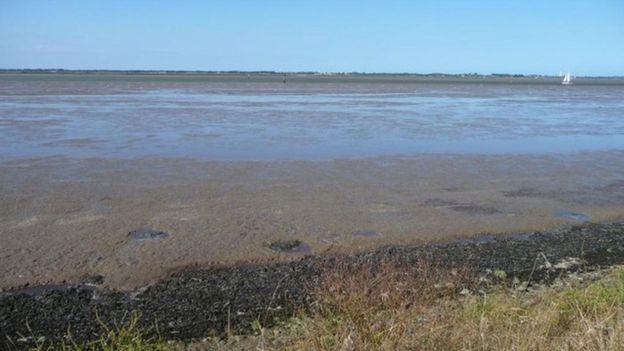 Another favourite river walk is the Nar Valley Way. We’ve walked from Gressenhall (near the source) back to Narborough several times and have done the Narborough to King’s Lynn stretch too. It’s more valley than river, although the river does pop up in surprising places along the way. My favourite stretch is Narborough to Castle Acre. Early on in the walk there’s a distant view of Narford Hall, seat of the Fountaines, where in the 1960s Andrew Fountaine, founder member of the BNP created an annual Aryan camp. Or perhaps we’re better off remembering Margaret Fountaine of South Acre, diarist, lepidopterist and explorer in an era (1890s onward) when this was just not “done”, especially as it seems that the much-travelled Margaret may have had an “affectionate relationship” with her guide and trasnlator of 27 years, Khalil Neimy. The large number of monastic ruins strewing the countryside are a great feature of the walk, all found near clean flowing water to meet the monks’ needs. Walking past The Stag at West Acre and then down to the Fords, you get tantalising glimpses of the ruined priory of West Acre before crossing the water meadows and coming out at the ruins of Castle Acre, a Cluniac Priory dating back to 1090.
Another favourite river walk is the Nar Valley Way. We’ve walked from Gressenhall (near the source) back to Narborough several times and have done the Narborough to King’s Lynn stretch too. It’s more valley than river, although the river does pop up in surprising places along the way. My favourite stretch is Narborough to Castle Acre. Early on in the walk there’s a distant view of Narford Hall, seat of the Fountaines, where in the 1960s Andrew Fountaine, founder member of the BNP created an annual Aryan camp. Or perhaps we’re better off remembering Margaret Fountaine of South Acre, diarist, lepidopterist and explorer in an era (1890s onward) when this was just not “done”, especially as it seems that the much-travelled Margaret may have had an “affectionate relationship” with her guide and trasnlator of 27 years, Khalil Neimy. The large number of monastic ruins strewing the countryside are a great feature of the walk, all found near clean flowing water to meet the monks’ needs. Walking past The Stag at West Acre and then down to the Fords, you get tantalising glimpses of the ruined priory of West Acre before crossing the water meadows and coming out at the ruins of Castle Acre, a Cluniac Priory dating back to 1090.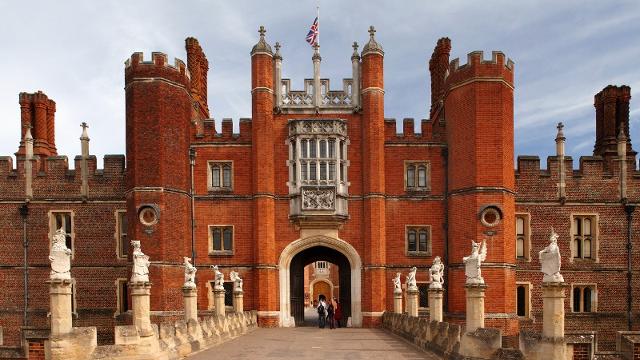 I guess it’s no suprise that I’m so attracted to rivers. My father was a boatbuilder and I grew up in Kingston-upon-Thames so the river was always a strong presence through my formative years. At the end of the road where I lived for most of my childhood was the Hogsmill, a tributary of the Thames which, one memorable evening, overflowed – I remember my mother furiously sweeping it back under the door. Kingston was well situated for visits to Kew Gardens on the bus with twopence entry posted in the honesty box. I would walk along the Thames to Hampton Court where under sixteens could get in for a couple of shillings. It’s probably here that my love of history began as I devoured Jean Plaidy and stood with my eyes closed in the Haunted Gallery where Catherine Howard is said to have begged Henry for her life, hoping to hear her cries.
I guess it’s no suprise that I’m so attracted to rivers. My father was a boatbuilder and I grew up in Kingston-upon-Thames so the river was always a strong presence through my formative years. At the end of the road where I lived for most of my childhood was the Hogsmill, a tributary of the Thames which, one memorable evening, overflowed – I remember my mother furiously sweeping it back under the door. Kingston was well situated for visits to Kew Gardens on the bus with twopence entry posted in the honesty box. I would walk along the Thames to Hampton Court where under sixteens could get in for a couple of shillings. It’s probably here that my love of history began as I devoured Jean Plaidy and stood with my eyes closed in the Haunted Gallery where Catherine Howard is said to have begged Henry for her life, hoping to hear her cries.
 And if tea really isn’t your tipple of choice then head back to Cambridge and check out Hot Numbers on Trumpington Street, just past the Fitzwilliam. This roastery and cafe really does know its beans, specialising in single origin coffee. I’ve had the most layered and tasty coffees ever here so do give it a try!
And if tea really isn’t your tipple of choice then head back to Cambridge and check out Hot Numbers on Trumpington Street, just past the Fitzwilliam. This roastery and cafe really does know its beans, specialising in single origin coffee. I’ve had the most layered and tasty coffees ever here so do give it a try! Somehow, though, as we mature, many of us lose our way and poetry becomes something alienating and elitist, seeming to belong to an academic world of closely guarded secrets which only the chosen few can access. I would say that poetry belongs everywhere, to us all, to the world and, although it has a commercial motivation, I’m delighted that the Nationwide Building Society are using poetry to speak to their wide-ranging potential customer base. At the moment I’m following a course run by the Poetry School and tutored by Emma Hammond. It’s called Hyperspectacle and we’re exploring poetry which occurs in unexpected places – tweets, internet review forums etc I feel quite evangelical about getting more and more people to enjoy poetry, to realise that they can’t like it all, and if they don’t it’s not their fault but to keep on looking until they find something that speaks to them. There’s so much poetry out there at the moment, but it’s a bit like a dating website, you have to persevere to find your match!
Somehow, though, as we mature, many of us lose our way and poetry becomes something alienating and elitist, seeming to belong to an academic world of closely guarded secrets which only the chosen few can access. I would say that poetry belongs everywhere, to us all, to the world and, although it has a commercial motivation, I’m delighted that the Nationwide Building Society are using poetry to speak to their wide-ranging potential customer base. At the moment I’m following a course run by the Poetry School and tutored by Emma Hammond. It’s called Hyperspectacle and we’re exploring poetry which occurs in unexpected places – tweets, internet review forums etc I feel quite evangelical about getting more and more people to enjoy poetry, to realise that they can’t like it all, and if they don’t it’s not their fault but to keep on looking until they find something that speaks to them. There’s so much poetry out there at the moment, but it’s a bit like a dating website, you have to persevere to find your match!
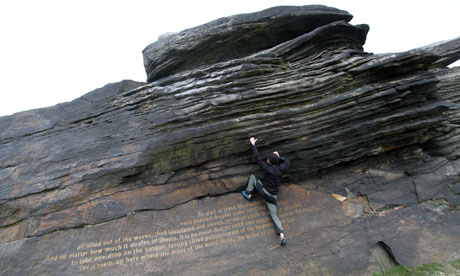




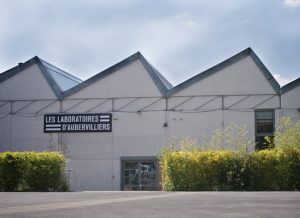 All photos courtesy of The Ark: Center for Experimentation Grace Ndiritu Laboratories d’Aubervilliers, Paris
All photos courtesy of The Ark: Center for Experimentation Grace Ndiritu Laboratories d’Aubervilliers, Paris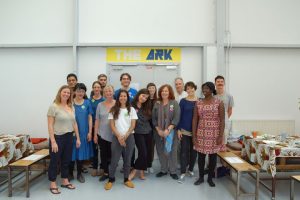
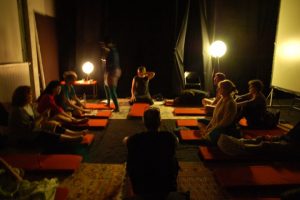


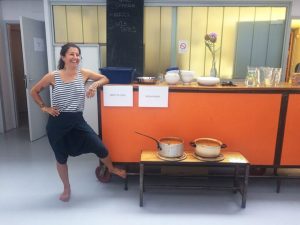
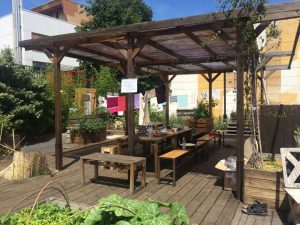 Particularly striking were the giant cardooms and the whole space was enhanced by the presence of Josette and Margeurite, the resident hens. The yard gates were the limit of our world and as we socialised in the garden in the evenings we could hear dance music from the theatre next door. There was also quite a famous boxing club there and we watched the comings and goings from afar.
Particularly striking were the giant cardooms and the whole space was enhanced by the presence of Josette and Margeurite, the resident hens. The yard gates were the limit of our world and as we socialised in the garden in the evenings we could hear dance music from the theatre next door. There was also quite a famous boxing club there and we watched the comings and goings from afar.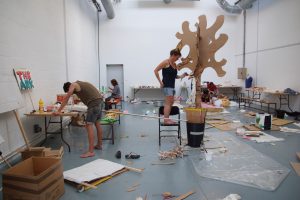 In the afternoons we made masks and costumes, led by talented artists Urara Tsuchiya and Anna Tanner. This was for the grand finale of The Ark project– a street carnival parade of extinct animals, reverse Darwinism in action. I was on megaphone duty shouting slogans in French and English through the bemused but entertained streets of Aubervilliers, resplendent in tie-dye and blue face paint!
In the afternoons we made masks and costumes, led by talented artists Urara Tsuchiya and Anna Tanner. This was for the grand finale of The Ark project– a street carnival parade of extinct animals, reverse Darwinism in action. I was on megaphone duty shouting slogans in French and English through the bemused but entertained streets of Aubervilliers, resplendent in tie-dye and blue face paint!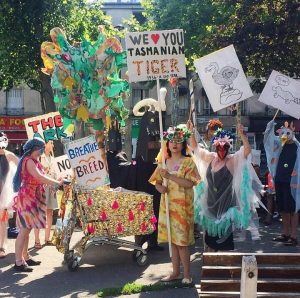
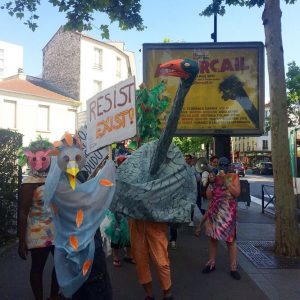
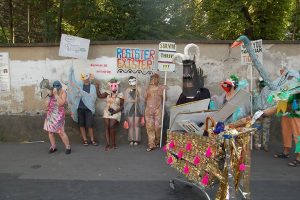
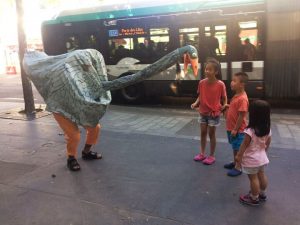

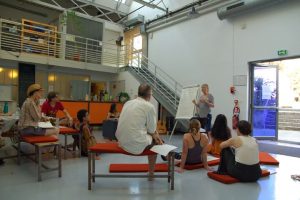
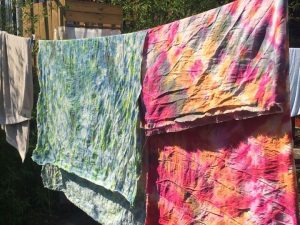 I loved the way our community developed – after no contact with the outside world it was both a wonder and a shock to communicate with the staff at the Labos after days of smiling but not talking and then to venture further afield to interact with the local community. By the end of the day we were also dancing like mad to a great selection of music, with Max and Julian DJ-ing as the street parade was followed by a public barbecue. The following day the Labos opened to the public for academic round-table discussions. The timing was perfect, who knows what would have happened if we’d been Arkees for longer, as over the week we had gone feral – enjoying the outdoor shower (it was a really hot week), spraying each other with water to cool down, gradually losing our flip-flops to go barefoot, eating with our hands Southern Indian style, wearing more and more makeshift outfits to cope with the heat (I ended up wearing the bit of cloth I’d taken as a pillowslip as a sarong for most of the week!).
I loved the way our community developed – after no contact with the outside world it was both a wonder and a shock to communicate with the staff at the Labos after days of smiling but not talking and then to venture further afield to interact with the local community. By the end of the day we were also dancing like mad to a great selection of music, with Max and Julian DJ-ing as the street parade was followed by a public barbecue. The following day the Labos opened to the public for academic round-table discussions. The timing was perfect, who knows what would have happened if we’d been Arkees for longer, as over the week we had gone feral – enjoying the outdoor shower (it was a really hot week), spraying each other with water to cool down, gradually losing our flip-flops to go barefoot, eating with our hands Southern Indian style, wearing more and more makeshift outfits to cope with the heat (I ended up wearing the bit of cloth I’d taken as a pillowslip as a sarong for most of the week!).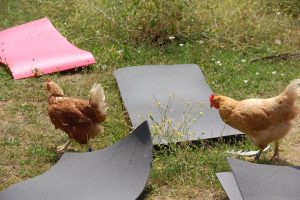
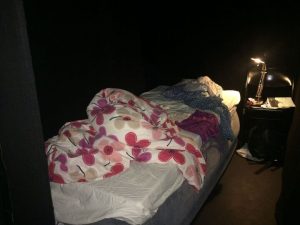

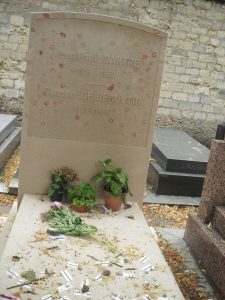
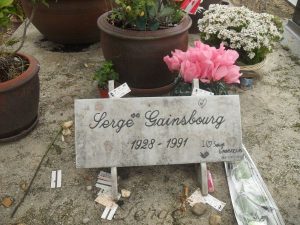 Coincidentally (or not!), Gainsbourg is also buried at Montparnasse Cemetery along with other greats such as the poet Baudelaire, who is influential in my constant attempts to write flaneur poems; Jean Seberg, star of one of my favourite new-wave films, Breathless; Henri Langlois who ensured that French film was preserved and celebrated in a way that befitted its importance by heading up the Cinemathèque Française and who was the revered and beloved mentor of FrançoisTruffaut and Jean-Luc Godard; and not forgetting Jacques Demy, film-making husband of one of my favourite directors, Agnes Varda.
Coincidentally (or not!), Gainsbourg is also buried at Montparnasse Cemetery along with other greats such as the poet Baudelaire, who is influential in my constant attempts to write flaneur poems; Jean Seberg, star of one of my favourite new-wave films, Breathless; Henri Langlois who ensured that French film was preserved and celebrated in a way that befitted its importance by heading up the Cinemathèque Française and who was the revered and beloved mentor of FrançoisTruffaut and Jean-Luc Godard; and not forgetting Jacques Demy, film-making husband of one of my favourite directors, Agnes Varda.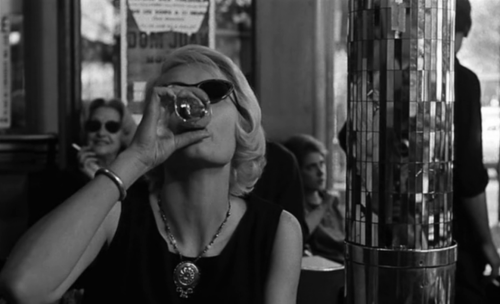

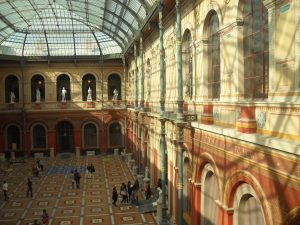
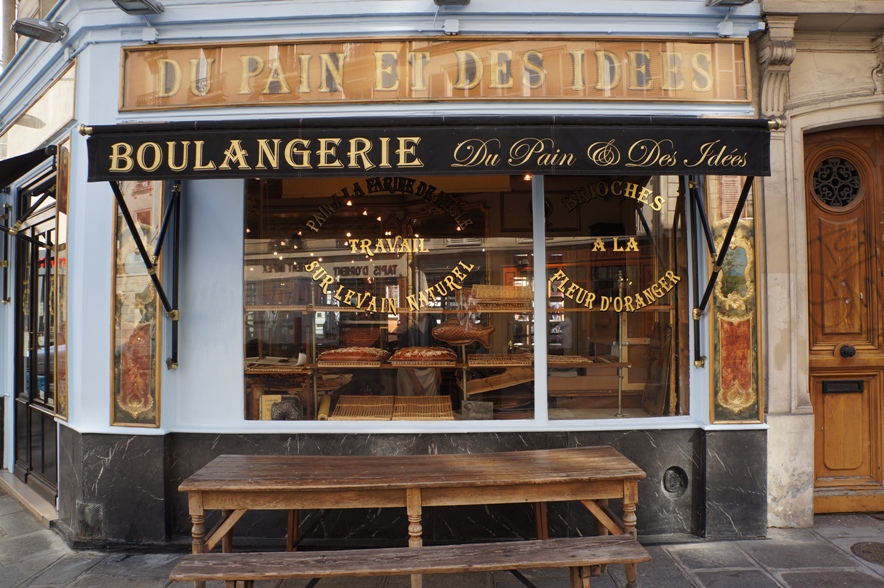
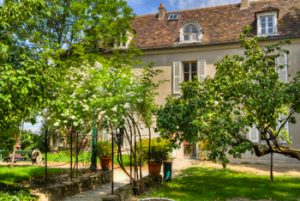 lived. The Renoir garden is a beautiful place for a coffee or lunch. The buildings are among the oldest in Montmartre and with their shutters and natural gardens and view over the vineyards of Montmartre it feels as if you are back in the original village. My goal for this visit was the Demarne Hotel – the building which houses the Museum’s temporary exhibitions. Many impressionist painters lived and worked here as did Père Tanguy, the famous art dealer. It was also home to Claude de la Rose, one of Molière’s troupe of actors but today it was housing the fantastic exhibition “Montmartre – Décor de Cinema” a celebration of the area as a cinematic location. There’s so much to enjoy, it’s an excellently curated exhibition with a wealth of film clips. There’s a whole space dedicated to Amélie, a look at Truffaut’s use of Montmartre Cemetery and Place de Clichy, but the two films which are now at the top of my wish-list were directed by Marcel Carné, La Porte de la Nuit featuring an incredibly detailed studio reproduction of the metro station at Barbès Rochechouart, which used to be my local, and Juliette ou La Clef des Songes which lured me in immediately with its air of doomed love.
lived. The Renoir garden is a beautiful place for a coffee or lunch. The buildings are among the oldest in Montmartre and with their shutters and natural gardens and view over the vineyards of Montmartre it feels as if you are back in the original village. My goal for this visit was the Demarne Hotel – the building which houses the Museum’s temporary exhibitions. Many impressionist painters lived and worked here as did Père Tanguy, the famous art dealer. It was also home to Claude de la Rose, one of Molière’s troupe of actors but today it was housing the fantastic exhibition “Montmartre – Décor de Cinema” a celebration of the area as a cinematic location. There’s so much to enjoy, it’s an excellently curated exhibition with a wealth of film clips. There’s a whole space dedicated to Amélie, a look at Truffaut’s use of Montmartre Cemetery and Place de Clichy, but the two films which are now at the top of my wish-list were directed by Marcel Carné, La Porte de la Nuit featuring an incredibly detailed studio reproduction of the metro station at Barbès Rochechouart, which used to be my local, and Juliette ou La Clef des Songes which lured me in immediately with its air of doomed love.